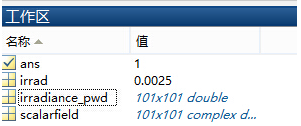`A�\,$(q+ 简介:
FRED作为COM组件可以实现与Excel、VB、
Matlab等调用来完成庞大的计算任务或画图,本文的目的是通过运行一个案例来实现与Matlab的相互调用,在此我们需要借助脚本来完成,此脚本为视为通用型脚本。
+M��ZsL7�% n8 UG�{.
= 配置:在执行调用之前,我们需要在Matlab命令行窗口输入如下命令:
^�AhV1rBB� enableservice('AutomationServer', true)
��_E %�!5u enableservice('AutomationServer')
���j<NZ4Rf  ly[�j=v�BV
ly[�j=v�BV 结果输出为1,这种操作方式保证了当前的Matlab实体可以用于
通信。
VAW:h5j2@� w#6)XR|+,. 在winwrp界面,为增加和使用Matlab类型的目录库,我们需要如下步骤:
�E�c/�&?|$ 1. 在FRED脚本编辑界面找到参考.
4�y*"w*L�� 2. 找到Matlab Automation Server Type Library
i%@bl�z:_Y 3. 将名字改为MLAPP
[~NJf3�c" �Xw�p6]�lx ;*%3J$��T+ 在Matlab里面有两种常用的数据发送选项PutWorkspaceData 及PutFullMatrix,PutWorkspaceData适用于存储一般的数据在工作区,并赋予其为变量,PutFullMatrix试用于复数数据。
t=nZ1�GZyM 图 编辑/参考
�cM�s8��D �e5AZU7%�. M�mmg�3%G1 现在将脚本代码公布如下,此脚本执行如下几个步骤:
�E] 6]c!2: 1. 创建Matlab服务器。
UuS6y9�@v� 2. 移动探测面对于前一聚焦面的位置。
e&@;h�DmIX 3. 在探测面追迹
光线 �bG��)EZ�� 4. 在探测面计算
照度 =jEVHIYt�� 5. 使用PutWorkspaceData发送照度数据到Matlab
+D+�v j|fn 6. 使用PutFullMatrix发送标量场数据到Matlab中
'Vp��zB
s# 7. 用Matlab画出照度数据
��g^l~A�R 8. 在Matlab计算照度平均值
FEH+ �PKSc 9. 返回数据到FRED中
N�uf�Rd�/q r01�u�3!� 代码分享:
?B+]Ex(\B, ^HhV�?I�qg Option Explicit
Sw�.k�,p*r mz�f~qV^T� Sub Main
&w!(.u�DO� ���R ;k1(p Dim ana As T_ANALYSIS
�2c*w{�\�X Dim move As T_OPERATION
��,�ZI#p�6 Dim Matlab As MLApp.MLApp
'y�o-`nNFD Dim detNode As Long, detSurfNode As Long, anaSurfNode As Long
/IQ$[WR cx Dim raysUsed As Long, nXpx As Long, nYpx As Long
0fGt7 "��Q Dim irrad() As Double, imagData() As Double, reals() As Double, imags() As Double
��|.K��B� Dim z As Double, xMin As Double, xMax As Double, yMin As Double, yMax As Double
4��wKQs�&: Dim meanVal As Variant
!J&�UO�/q. ��8-_�atL Set Matlab = CreateObject("Matlab.Application")
~|G`f\Ln"� /HH_Zi0?N| ClearOutputWindow
l(�Ya�,/4 �7@R^B�=pb 'Find the node numbers for the entities being used.
0�0B,1Q HP detNode = FindFullName("Geometry.Screen")
��b�*(,�W detSurfNode = FindFullName("Geometry.Screen.Surf 1")
i>7]9gBm1q anaSurfNode = FindFullName("Analysis Surface(s).Analysis 1")
�>��*/:"!u �`_()|;�!y 'Load the properties of the analysis surface being used.
XXw>�h�4hl LoadAnalysis anaSurfNode, ana
�E��K.n�
$ �5g%D0_e�5 'Move the detector custom element to the desired z position.
URbHVPCPb z = 50
j[Jwa*�GQP GetOperation detNode,1,move
"8p<NsU��� move.Type = "Shift"
Q#F9&{'�l move.val3 = z
xS4?M<|L63 SetOperation detNode,1,move
�J`4V\D�}n Print "New screen position, z = " &z
�0GW6�9� z -m�P2}BN�M 'Update the model and trace rays.
�=F�c}T%� EnableTextPrinting (False)
�#kk5�{*` Update
"/�G]���M& DeleteRays
SP\s{,'F-b TraceCreateDraw
ev��#/v:$? EnableTextPrinting (True)
��m
�7S`�u DU�SQh�+C� 'Calculate the irradiance for rays on the detector surface.
� �1p�K(tm raysUsed = Irradiance( detSurfNode, -1, ana, irrad )
O=eU38n:5u Print raysUsed & " rays were included in the irradiance calculation.
K���5Rg�WP <*�I*#WI&B 'When using real number data to send to MATLAB, it is simplest to use PutWorkspaceData.
t7y���vd7� Matlab.PutWorkspaceData("irradiance_pwd","base",irrad)
f���%3MDI� `,O"^zR)z� 'PutFullMatrix is more useful when actually having complex data such as with
!U�R�3`�Xk 'scalar wavefield, for example. Note that the scalarfield array in MATLAB
��U'^ G-@� 'is a complex valued array.
R�h!m�1Q(- raysUsed = ScalarField ( detSurfNode, -1, ana, reals, imags )
*0vRVlY�f Matlab.PutFullMatrix("scalarfield","base", reals, imags )
�6"[J�[7up Print raysUsed & " rays were included in the scalar field calculation."
FJq�����g, s?"�\+�b� 'Calculate plot characteristics from the T_ANALYSIS structure. This information is used
'�py�IMB?x 'to customize the plot figure.
t%%zuq��F` xMin = ana.posX+ana.AcellX*(ana.Amin-0.5)
<�`WDNi$Y xMax = ana.posX+ana.AcellX*(ana.Amax+0.5)
x:i,�l:�x� yMin = ana.posY+ana.BcellY*(ana.Bmin-0.5)
aeVd.�`lxM yMax = ana.posY+ana.BcellY*(ana.Bmax+0.5)
�}~D�o0XUH nXpx = ana.Amax-ana.Amin+1
uGn� BlR$} nYpx = ana.Bmax-ana.Bmin+1
b'C#�]DorE ~]24">VZ�f 'Plot the data in Matlab with some parameters calculated from the T_ANALYSIS
�s1�R�#X~d 'structure. Set the axes labels, title, colorbar and plot view.
z0�x^HDAeC Matlab.Execute( "figure; surf(linspace("&xMin &","&xMax &","&nXpx &"),linspace("& yMin &"," & yMax & "," & nYpx & "),irradiance_pwd, 'EdgeColor', 'None');" )
!u:Fn)�j�� Matlab.Execute( "xlabel('X Position (" & GetUnits() & ")')" ) : Matlab.Execute( "ylabel('Y Position (" & GetUnits() & ")')" ) : Matlab.Execute( "zLabel( 'Irradiance' )" )
OL��Wn���0 Matlab.Execute( "title('Detector Irradiance')" )
|'lN���R)5 Matlab.Execute( "colorbar" )
o^/ fr&,9� Matlab.Execute( "view(2)" )
�U# IPYyV Print ""
AHMvh� 7O? Print "Matlab figure plotted..."
"!&
o�|!2� �L8�Q/!+K 'Have Matlab calculate and return the mean value.
t�J*�/5k
& Matlab.Execute( "irrad = mean(mean(irradiance_pwd));" )
��1c�x%+�- Matlab.GetWorkspaceData( "irrad", "base", meanVal )
G��O"E>FyB Print "The mean irradiance value calculated by Matlab is: " & meanVal
+vH#x�c�\' ?&!!(dWFH� 'Release resources
QkWEVL@�uM Set Matlab = Nothing
9ei<�ou_�s }O+S}�Hbwy End Sub
^$m�CF%e8H mE=Tj%+��x 最后在Matlab画图如下:
Q-A_�����8 ��m<L��zgX 并在工作区保存了数据:
R��5mb4���  �C�8��i4z�
�C�8��i4z� 并返回平均值:
p.<���d+S< e�A3���NyL 与FRED中计算的照度图对比:
bMsThoePT� A/&u��/?*C 例:
�O>I�%��O^ ��G^�z>2P� 此例
系统数据,可按照此数据建立
模型 M04�u>|�
, @\:@_}Z`_} 系统数据
`Ba�?4_>�k 0C3Y =���F O�'�(�D:D? 光源数据:
"r8N-
h/P� Type: Laser Beam(Gaussian 00 mode)
asE.��!g? Beam size: 5;
f
�=A�#:�d Grid size: 12;
&�_s^�C�?x Sample pts: 100;
Gm�> =�s� 相干光;
(w+Sm�D��� 波长0.5876微米,
IG�o5b-ds� 距离原点沿着Z轴负方向25mm。
_m���Qj�= Z#l6�B�X�K 对于执行代码,如果想保存图片,请在开始之前一定要执行如下代码:
z�Tl,VIa3p enableservice('AutomationServer', true)
t?b@l<,�s enableservice('AutomationServer')